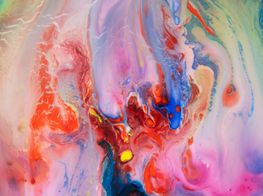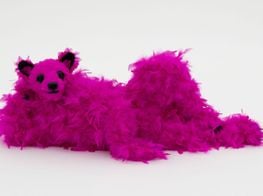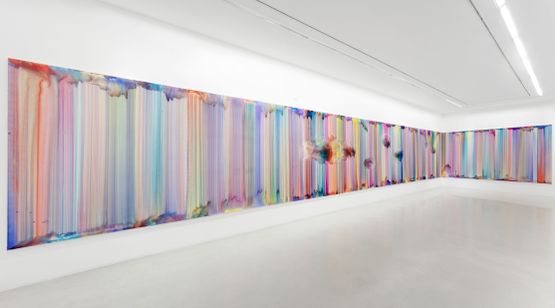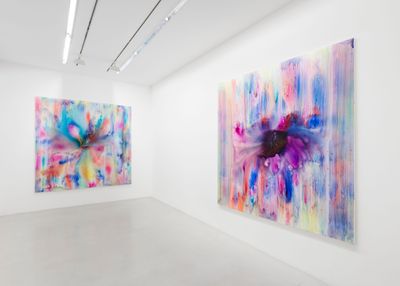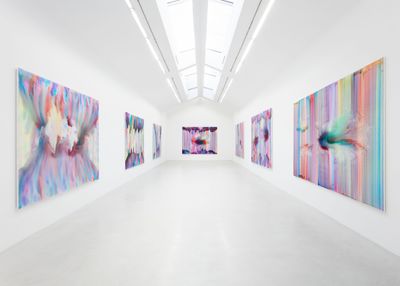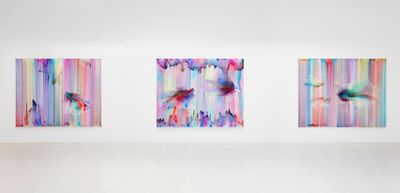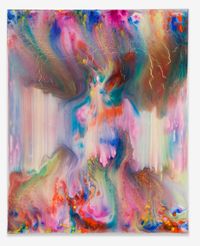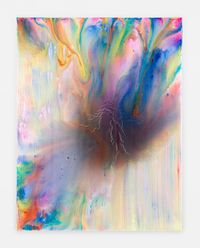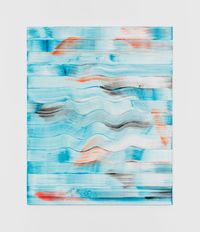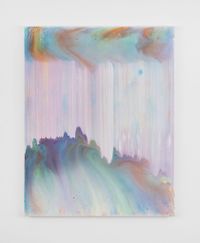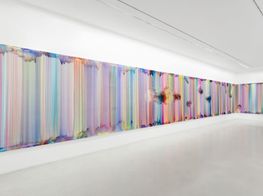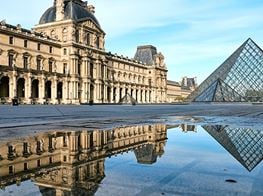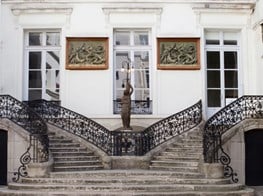Bernard Frize on the Contradictions of Painting
Sponsored Content | Perrotin
Bernard Frize. Photo: Philippe Chancel.

Bernard Frize. Photo: Philippe Chancel.
Bernard Frize has remained loyal to his singular approach which, for the past 45 years, has led him to develop a body of work focused on questioning the process of image-making through paint. Not only is he concerned with the act of painting itself, but also the way in which his works are exhibited, inviting viewers to feel and question what is presented to them.
To invigorate and develop his concept, Frize works in series. The artist establishes specific protocols and procedures at the outset of each work, using each to feed into and build a framework for the next, generating what ultimately constitutes and characterises his painting.
Irrespective of the pretext-themes or patterns chosen (such as braids, knots, grids, stripes, drips, interweavings, layers, entanglements, or friezes) and regardless of the colour combinations used, each canvas and series tend towards the same objective: the refusal of any representation and any subjectivity.
Instead, the intention is to highlight what constitutes painting: the intention, strategy, arm gestures, brushstrokes, chromatic relationships, interplays of surface and depth or transparency and opacity, textural effects, or phenomena of oppositions (between, for example, a sensual aspect or even the softness of the surface of the canvas and the distancing or even inherent coldness to the process).
Frize's painting practice is deliberately paradoxical: this is precisely what makes it fascinating—hypnotic—from both an intellectual and sensory point of view.
Entitled Les choses que j'ai vues (Things I've Seen) (20 April–24 May 2023) with a good dose of humour, Frize's ninth exhibition at Perrotin's Paris gallery (and his 19th across Perrotin's global sites since the beginning of his collaboration with the gallery in 1994), is a wonderful demonstration of this. It is a masterclass in painting, as well as a discourse on method in some respects.
HFDThis exhibition is once again proof that you have always worked in series. Why is that?
BFFirstly, I'm not good at one-off paintings; I need to warm up and experiment across several similar paintings. Secondly, focusing on a series also allows me to find an ending and a way out. Repetition offers me the possibility of specifying what I want to do and at the same time, opens a way out to begin the next series.
HFDSo how exactly are these series linked together? How do you move from one to the next?
BFIt's a total mystery! In the current exhibition, for example, there are elements in these paintings that derive from previous series. So certain fragments can generate a tool with which I can pass from one series to the next. When I pick up on this connection, the new series can start almost accidentally.
But it's a question I'm having trouble answering, because I don't want to give too literal an answer. I also find it very difficult to be certain about anything now, not only in painting, but also politically and socially. And I think my work reflects this uncertainty, this impossibility of defining an order or an image.
HFDOr a logic perhaps, as well?
BFYes, absolutely. The question is there, but it cannot be answered; the problem is insoluble. This is essentially the meaning of this new series. The previous ones were very organised and were always based on the motif of the grid, but this time the grid is totally dissolved within the colour and in the flow of the paint.
HFDYou have often said that your series are the result of a strategy, a programme, or even a protocol. How are they set up?
BFI don't know how to start a painting if I don't have an idea. So, in principle, when I start, I have an idea. I then try to find its realisation through the process of painting. I never plaster an idea onto a painting, rather it is through the process that I realise and clarify the idea that I began with, and sometimes that involves completely contradicting it.
Regarding the series presented, I was making very organised compositions with a grid and suddenly, I let myself be overwhelmed by the material conditions. I was able to accept it because it reminded me of canvases I had painted in the past where fluidity, viscosity, abundance, and movement served a practical purpose and allowed me to generate an image. My new creations are in this vein, meaning that we barely see the strategy that I have put in place, since the paint has overflowed and taken over.
HFDCould we call this a method?
BFNormally, yes. The method is, however, buried under the material conditions of the paintings, which conceal it. In the end, the mastery is not there, is no longer there—the method has disappeared under the conditions of its realisation.
HFDDoes this pose a problem?
BFNot at all, I'm very happy with it. In a way, it gives rise to more humble paintings, since I have no authority over them. My action is limited, which suits me well because I've never wanted to be a demiurge...
At any rate, there are several logics: Sol LeWitt put in place a painting strategy that makes it possible not to be a demiurge and to withdraw completely. I have always subscribed to this spirit: not to be too present, not to foreground my ego, and not to choose colours or anything else.
I have always thought that the exercise of painting is the management of contradictions.
My new series is the culmination of all that. I make so very few decisions that the painting prevails on its own accord, but in order to achieve that, I have still had to make decisions in advance. And I am aware of the paradox.
HFDWhere does randomness sit within this method?
BFTo what extent, I don't know. But it is clear that part of the creative process results from randomness. Randomness is one of the elements of life, so I don't see why I should deprive myself of it. Why create a world in which one compares oneself to god? It has never seemed useful to me to want to control everything.
HFDYou have just mentioned the paradox between decision-making and chance. Is there also a paradox that exists between the distance and a kind of coldness that you affirm, imposed by protocols, and the very gentle aspect of the surface of your canvases and the chromatic harmonies that they present?
BFYes, of course. I have always thought that the exercise of painting is the management of contradictions. The more paradoxes there are, the more interesting the painting. A painting that you can't look at twice because it immediately reveals itself fully upon first glance doesn't interest me. If a painting is simply the result of a recipe, it does not speak to me. On the other hand, if the elements are in contradiction, then they create a discourse, an intention or statement.
I like that there are decisions, and that these decisions can be contradicted, that they are in perpetual negotiation and that these negotiations are visible to viewers. I am absolutely not concerned with whether or not a painting matches the curtains in the living room. Above all, it is important to me that it has more to say on an intellectual level. At the same time, I don't see why a painting shouldn't be pleasant to look at, why it would need to be austere and off-putting.
HFDIn this regard, it has often been said that you were the painter of colour. What do you think about this?
BFI don't think I am at all. On the one hand, I always use the same eight colours, which give me so many possibilities and combinations that I don't see why I should change them. Besides, it's been years and years since I've changed my palette. I just want my colours to be distinct from one another. So I take two different blues, two different reds, two yellows, and so on. The range is always the same, which does not really matter in the end.
Besides, most of the time I only paint with five or six colours. They are very pure, so they mix and allow all the necessary variations. This is like four-colour process printing in photography, in which the same four colours are used to print any image. It is then up to the photographer to know how to enhance their subject. It's the same way for me... Maybe it's my past as a printer that makes me think like that.
HFDWhat is the role of these colours?
BFThey have a role of 'nomination'. They name things, places, and what counts and what doesn't, what constitutes a design and what doesn't. In short, their main role is to differentiate themselves from neighbouring colours.
HFDYou left Paris in 2004 to live in Berlin. Has this context had, at one time or another, an influence on your work?
BFI don't think so. I've enjoyed Berlin for the encounters that I've had there, and the contacts I've made. I was also glad to be outside of France, which did not do me many favours. But this is no longer the case and I've lost interest in Berlin. Berlin has entered a capitalist world that does not interest me at all, with artist studios where dozens of assistants work. It doesn't suit me. The art there has turned into small business ventures and so for me that experience is over, the adventure is over and done with. In fact I plan to return to France.
HFDIn the very early 2000s, you worked with a few assistants. Is this still the case today?
BFNo, not at all. I worked with assistants for four or five years, then I stopped in 2004 or 2005 because I reached the end of what I could do with them. They weren't assistants, actually; they were more like additional hands.
The principle was as follows: I took a brush loaded with paint, which I applied to the canvas. I gave it to someone who did the same thing, and then gave it to someone else, who gave it back to me, for example, and all this without ever breaking contact with the canvas. We drew diagrams and painted together in a way that is quite far removed from what is meant by the word 'assistant'. Today I do everything on my own.
HFDIf someone who hasn't seen your work before asks you at a dinner party what you paint, what do you answer?
BFI would be very uneasy, because I think if we could talk about painting, we wouldn't need to do it. Painting is something that must be seen before it is spoken about. And in any case, its surrounding discourse will never be exhausted. I think my response to this question would be that it is very difficult to discuss this subject while eating [laughs]. —[O]

